Legal Analysis of Redundancy Law for Business Managers - Report
VerifiedAdded on 2019/12/28
|12
|3896
|29
Report
AI Summary
This report examines the legal aspects of redundancy within a management consultancy company facing financial difficulties. It begins by identifying key legal issues, such as employee rights to notice, redundancy pay, and consultation, as outlined in the Employment Relations Act 1996. The report then provides a factual description of the company's situation and explores alternative cost-cutting measures. An analysis of legal principles, including compulsory and voluntary redundancy, selection criteria, and collective consultation rules, is presented. The report critically assesses the law and its implementation, emphasizing the importance of compliance and fair treatment of employees. It concludes with a discussion and proposition of legal issues, offering insights into how the company can navigate the redundancy process while adhering to legal requirements and mitigating potential risks. The report provides a comprehensive overview of redundancy law and its practical application within a business context.

Law for Business
Managers
Managers
Paraphrase This Document
Need a fresh take? Get an instant paraphrase of this document with our AI Paraphraser
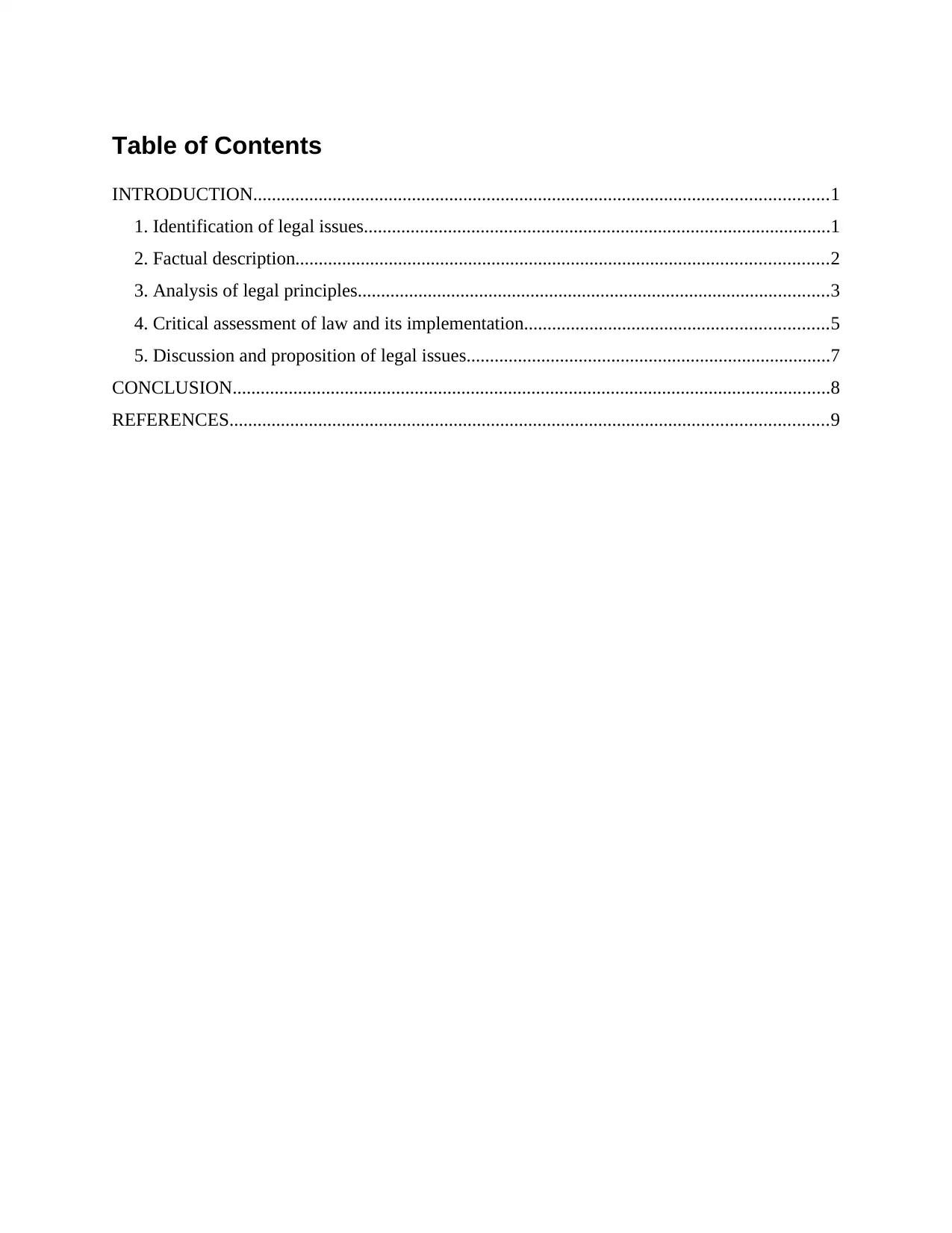
Table of Contents
INTRODUCTION...........................................................................................................................1
1. Identification of legal issues....................................................................................................1
2. Factual description..................................................................................................................2
3. Analysis of legal principles.....................................................................................................3
4. Critical assessment of law and its implementation.................................................................5
5. Discussion and proposition of legal issues..............................................................................7
CONCLUSION................................................................................................................................8
REFERENCES................................................................................................................................9
INTRODUCTION...........................................................................................................................1
1. Identification of legal issues....................................................................................................1
2. Factual description..................................................................................................................2
3. Analysis of legal principles.....................................................................................................3
4. Critical assessment of law and its implementation.................................................................5
5. Discussion and proposition of legal issues..............................................................................7
CONCLUSION................................................................................................................................8
REFERENCES................................................................................................................................9
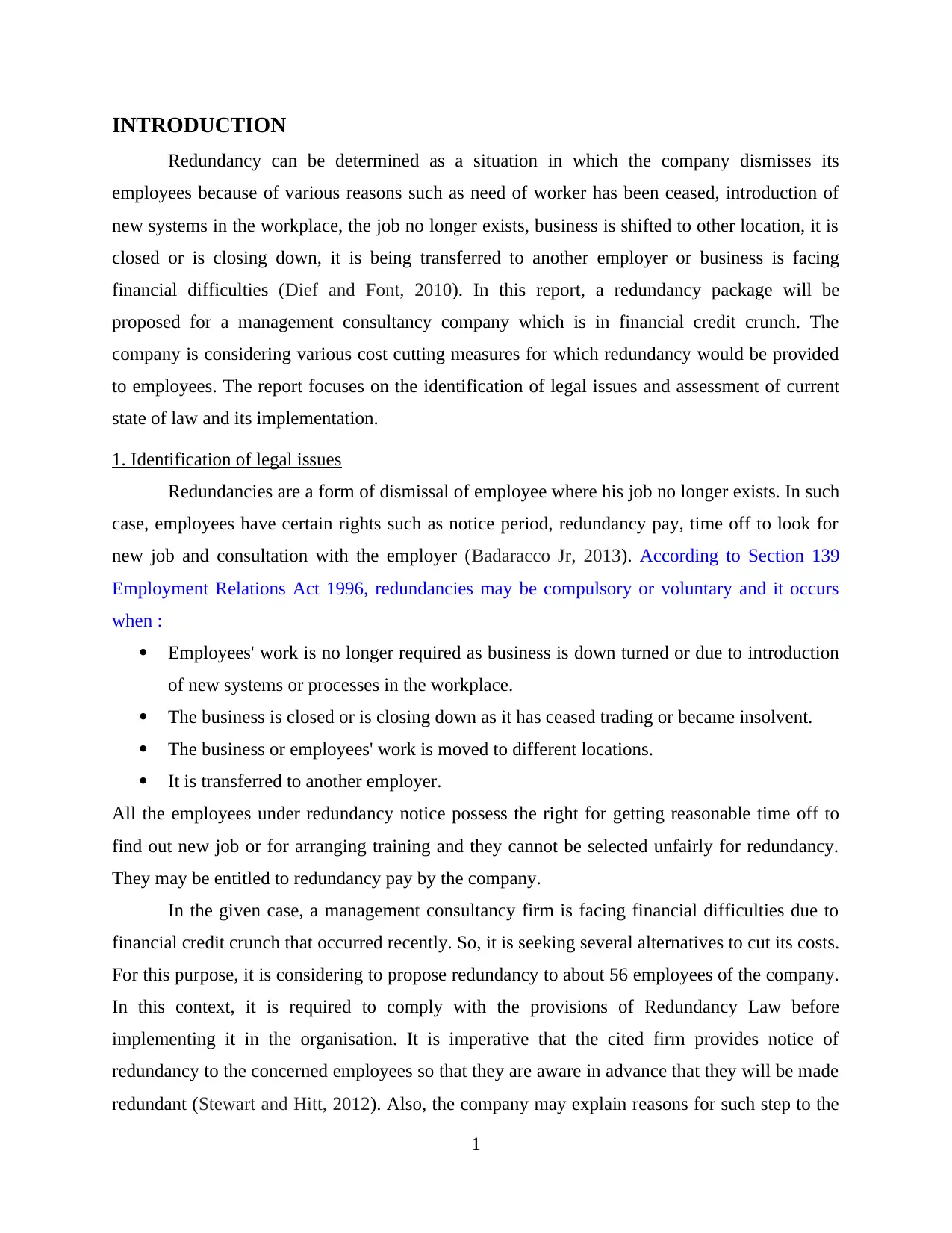
INTRODUCTION
Redundancy can be determined as a situation in which the company dismisses its
employees because of various reasons such as need of worker has been ceased, introduction of
new systems in the workplace, the job no longer exists, business is shifted to other location, it is
closed or is closing down, it is being transferred to another employer or business is facing
financial difficulties (Dief and Font, 2010). In this report, a redundancy package will be
proposed for a management consultancy company which is in financial credit crunch. The
company is considering various cost cutting measures for which redundancy would be provided
to employees. The report focuses on the identification of legal issues and assessment of current
state of law and its implementation.
1. Identification of legal issues
Redundancies are a form of dismissal of employee where his job no longer exists. In such
case, employees have certain rights such as notice period, redundancy pay, time off to look for
new job and consultation with the employer (Badaracco Jr, 2013). According to Section 139
Employment Relations Act 1996, redundancies may be compulsory or voluntary and it occurs
when :
Employees' work is no longer required as business is down turned or due to introduction
of new systems or processes in the workplace.
The business is closed or is closing down as it has ceased trading or became insolvent.
The business or employees' work is moved to different locations.
It is transferred to another employer.
All the employees under redundancy notice possess the right for getting reasonable time off to
find out new job or for arranging training and they cannot be selected unfairly for redundancy.
They may be entitled to redundancy pay by the company.
In the given case, a management consultancy firm is facing financial difficulties due to
financial credit crunch that occurred recently. So, it is seeking several alternatives to cut its costs.
For this purpose, it is considering to propose redundancy to about 56 employees of the company.
In this context, it is required to comply with the provisions of Redundancy Law before
implementing it in the organisation. It is imperative that the cited firm provides notice of
redundancy to the concerned employees so that they are aware in advance that they will be made
redundant (Stewart and Hitt, 2012). Also, the company may explain reasons for such step to the
1
Redundancy can be determined as a situation in which the company dismisses its
employees because of various reasons such as need of worker has been ceased, introduction of
new systems in the workplace, the job no longer exists, business is shifted to other location, it is
closed or is closing down, it is being transferred to another employer or business is facing
financial difficulties (Dief and Font, 2010). In this report, a redundancy package will be
proposed for a management consultancy company which is in financial credit crunch. The
company is considering various cost cutting measures for which redundancy would be provided
to employees. The report focuses on the identification of legal issues and assessment of current
state of law and its implementation.
1. Identification of legal issues
Redundancies are a form of dismissal of employee where his job no longer exists. In such
case, employees have certain rights such as notice period, redundancy pay, time off to look for
new job and consultation with the employer (Badaracco Jr, 2013). According to Section 139
Employment Relations Act 1996, redundancies may be compulsory or voluntary and it occurs
when :
Employees' work is no longer required as business is down turned or due to introduction
of new systems or processes in the workplace.
The business is closed or is closing down as it has ceased trading or became insolvent.
The business or employees' work is moved to different locations.
It is transferred to another employer.
All the employees under redundancy notice possess the right for getting reasonable time off to
find out new job or for arranging training and they cannot be selected unfairly for redundancy.
They may be entitled to redundancy pay by the company.
In the given case, a management consultancy firm is facing financial difficulties due to
financial credit crunch that occurred recently. So, it is seeking several alternatives to cut its costs.
For this purpose, it is considering to propose redundancy to about 56 employees of the company.
In this context, it is required to comply with the provisions of Redundancy Law before
implementing it in the organisation. It is imperative that the cited firm provides notice of
redundancy to the concerned employees so that they are aware in advance that they will be made
redundant (Stewart and Hitt, 2012). Also, the company may explain reasons for such step to the
1
⊘ This is a preview!⊘
Do you want full access?
Subscribe today to unlock all pages.

Trusted by 1+ million students worldwide
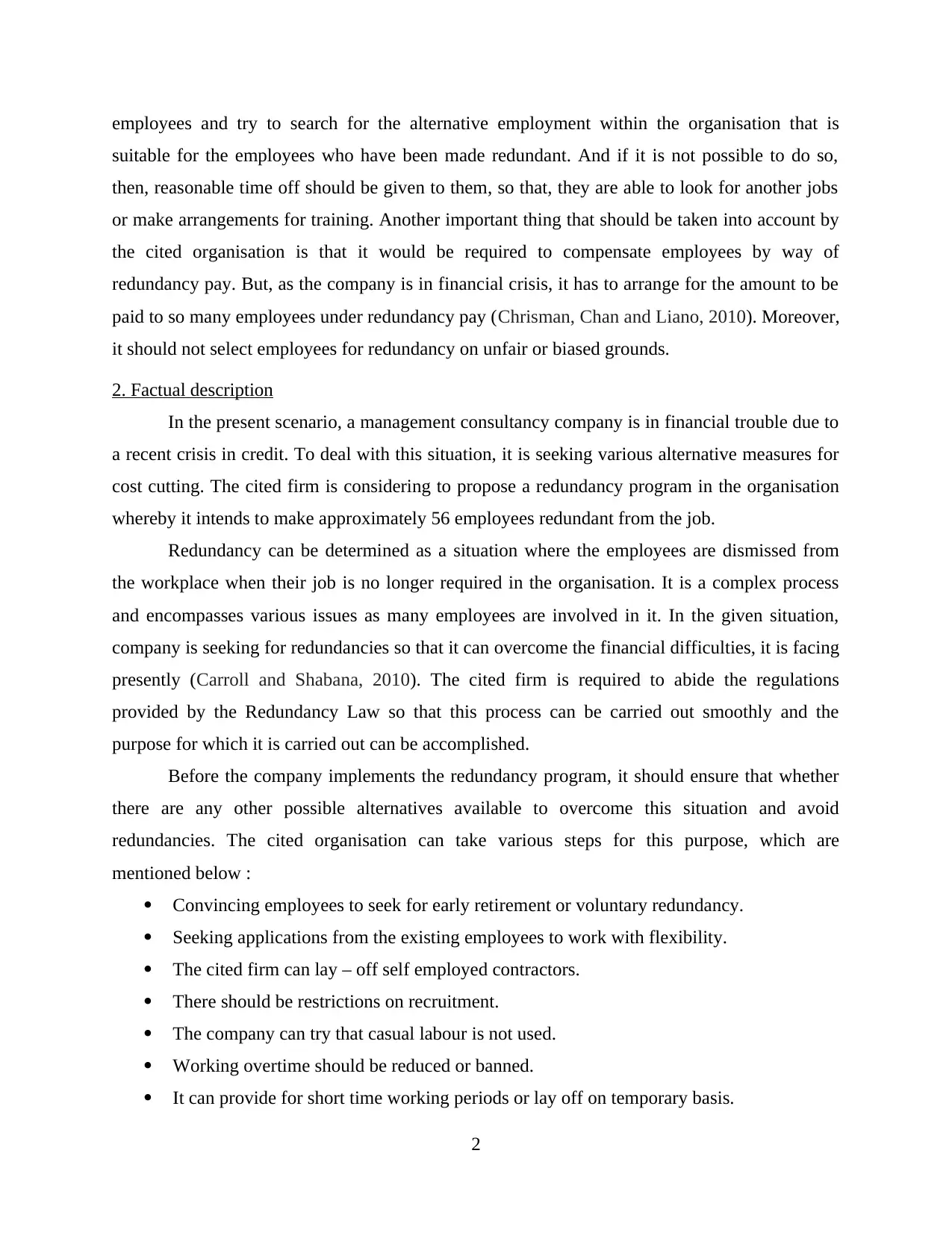
employees and try to search for the alternative employment within the organisation that is
suitable for the employees who have been made redundant. And if it is not possible to do so,
then, reasonable time off should be given to them, so that, they are able to look for another jobs
or make arrangements for training. Another important thing that should be taken into account by
the cited organisation is that it would be required to compensate employees by way of
redundancy pay. But, as the company is in financial crisis, it has to arrange for the amount to be
paid to so many employees under redundancy pay (Chrisman, Chan and Liano, 2010). Moreover,
it should not select employees for redundancy on unfair or biased grounds.
2. Factual description
In the present scenario, a management consultancy company is in financial trouble due to
a recent crisis in credit. To deal with this situation, it is seeking various alternative measures for
cost cutting. The cited firm is considering to propose a redundancy program in the organisation
whereby it intends to make approximately 56 employees redundant from the job.
Redundancy can be determined as a situation where the employees are dismissed from
the workplace when their job is no longer required in the organisation. It is a complex process
and encompasses various issues as many employees are involved in it. In the given situation,
company is seeking for redundancies so that it can overcome the financial difficulties, it is facing
presently (Carroll and Shabana, 2010). The cited firm is required to abide the regulations
provided by the Redundancy Law so that this process can be carried out smoothly and the
purpose for which it is carried out can be accomplished.
Before the company implements the redundancy program, it should ensure that whether
there are any other possible alternatives available to overcome this situation and avoid
redundancies. The cited organisation can take various steps for this purpose, which are
mentioned below :
Convincing employees to seek for early retirement or voluntary redundancy.
Seeking applications from the existing employees to work with flexibility.
The cited firm can lay – off self employed contractors.
There should be restrictions on recruitment.
The company can try that casual labour is not used.
Working overtime should be reduced or banned.
It can provide for short time working periods or lay off on temporary basis.
2
suitable for the employees who have been made redundant. And if it is not possible to do so,
then, reasonable time off should be given to them, so that, they are able to look for another jobs
or make arrangements for training. Another important thing that should be taken into account by
the cited organisation is that it would be required to compensate employees by way of
redundancy pay. But, as the company is in financial crisis, it has to arrange for the amount to be
paid to so many employees under redundancy pay (Chrisman, Chan and Liano, 2010). Moreover,
it should not select employees for redundancy on unfair or biased grounds.
2. Factual description
In the present scenario, a management consultancy company is in financial trouble due to
a recent crisis in credit. To deal with this situation, it is seeking various alternative measures for
cost cutting. The cited firm is considering to propose a redundancy program in the organisation
whereby it intends to make approximately 56 employees redundant from the job.
Redundancy can be determined as a situation where the employees are dismissed from
the workplace when their job is no longer required in the organisation. It is a complex process
and encompasses various issues as many employees are involved in it. In the given situation,
company is seeking for redundancies so that it can overcome the financial difficulties, it is facing
presently (Carroll and Shabana, 2010). The cited firm is required to abide the regulations
provided by the Redundancy Law so that this process can be carried out smoothly and the
purpose for which it is carried out can be accomplished.
Before the company implements the redundancy program, it should ensure that whether
there are any other possible alternatives available to overcome this situation and avoid
redundancies. The cited organisation can take various steps for this purpose, which are
mentioned below :
Convincing employees to seek for early retirement or voluntary redundancy.
Seeking applications from the existing employees to work with flexibility.
The cited firm can lay – off self employed contractors.
There should be restrictions on recruitment.
The company can try that casual labour is not used.
Working overtime should be reduced or banned.
It can provide for short time working periods or lay off on temporary basis.
2
Paraphrase This Document
Need a fresh take? Get an instant paraphrase of this document with our AI Paraphraser
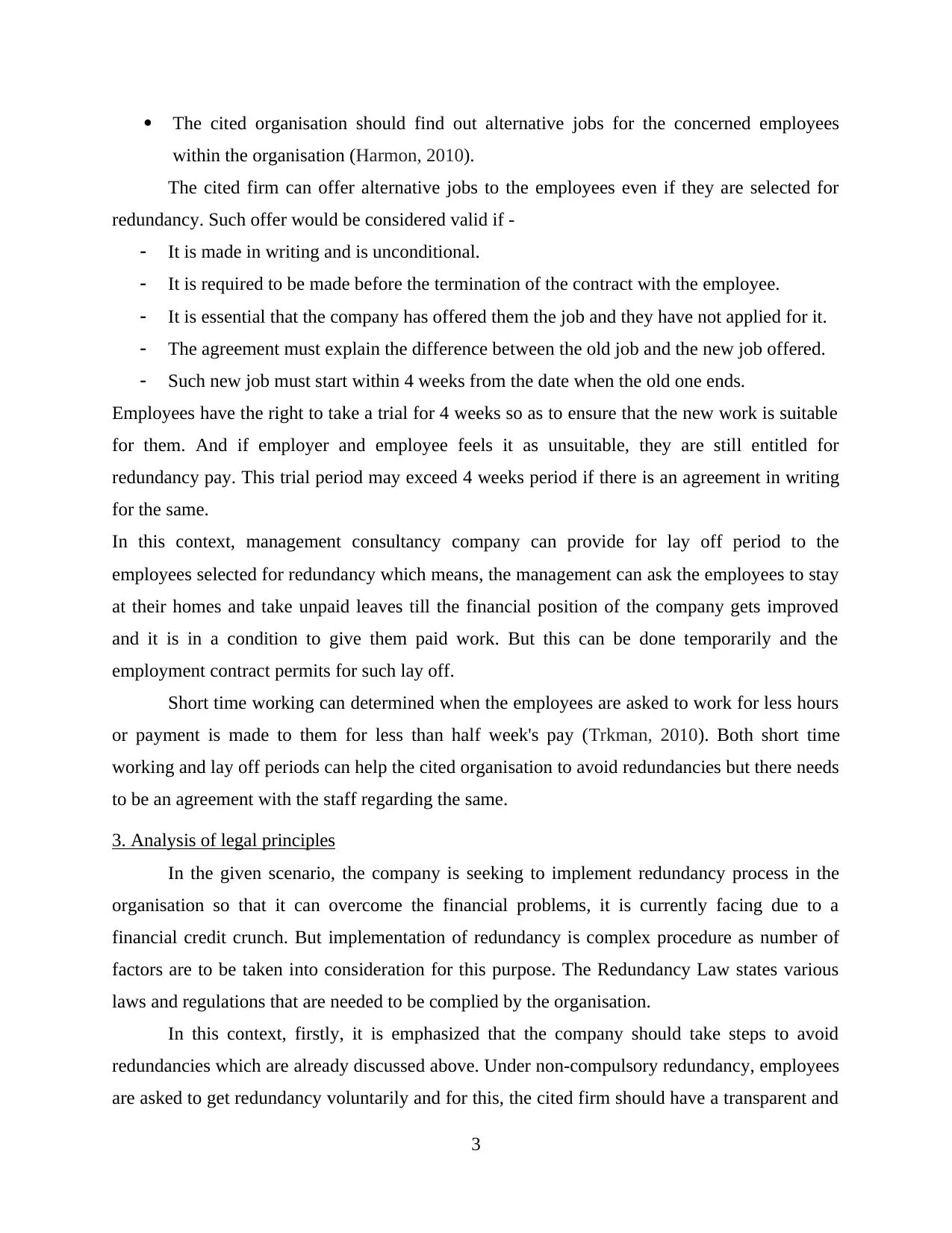
The cited organisation should find out alternative jobs for the concerned employees
within the organisation (Harmon, 2010).
The cited firm can offer alternative jobs to the employees even if they are selected for
redundancy. Such offer would be considered valid if -
It is made in writing and is unconditional.
It is required to be made before the termination of the contract with the employee.
It is essential that the company has offered them the job and they have not applied for it.
The agreement must explain the difference between the old job and the new job offered.
Such new job must start within 4 weeks from the date when the old one ends.
Employees have the right to take a trial for 4 weeks so as to ensure that the new work is suitable
for them. And if employer and employee feels it as unsuitable, they are still entitled for
redundancy pay. This trial period may exceed 4 weeks period if there is an agreement in writing
for the same.
In this context, management consultancy company can provide for lay off period to the
employees selected for redundancy which means, the management can ask the employees to stay
at their homes and take unpaid leaves till the financial position of the company gets improved
and it is in a condition to give them paid work. But this can be done temporarily and the
employment contract permits for such lay off.
Short time working can determined when the employees are asked to work for less hours
or payment is made to them for less than half week's pay (Trkman, 2010). Both short time
working and lay off periods can help the cited organisation to avoid redundancies but there needs
to be an agreement with the staff regarding the same.
3. Analysis of legal principles
In the given scenario, the company is seeking to implement redundancy process in the
organisation so that it can overcome the financial problems, it is currently facing due to a
financial credit crunch. But implementation of redundancy is complex procedure as number of
factors are to be taken into consideration for this purpose. The Redundancy Law states various
laws and regulations that are needed to be complied by the organisation.
In this context, firstly, it is emphasized that the company should take steps to avoid
redundancies which are already discussed above. Under non-compulsory redundancy, employees
are asked to get redundancy voluntarily and for this, the cited firm should have a transparent and
3
within the organisation (Harmon, 2010).
The cited firm can offer alternative jobs to the employees even if they are selected for
redundancy. Such offer would be considered valid if -
It is made in writing and is unconditional.
It is required to be made before the termination of the contract with the employee.
It is essential that the company has offered them the job and they have not applied for it.
The agreement must explain the difference between the old job and the new job offered.
Such new job must start within 4 weeks from the date when the old one ends.
Employees have the right to take a trial for 4 weeks so as to ensure that the new work is suitable
for them. And if employer and employee feels it as unsuitable, they are still entitled for
redundancy pay. This trial period may exceed 4 weeks period if there is an agreement in writing
for the same.
In this context, management consultancy company can provide for lay off period to the
employees selected for redundancy which means, the management can ask the employees to stay
at their homes and take unpaid leaves till the financial position of the company gets improved
and it is in a condition to give them paid work. But this can be done temporarily and the
employment contract permits for such lay off.
Short time working can determined when the employees are asked to work for less hours
or payment is made to them for less than half week's pay (Trkman, 2010). Both short time
working and lay off periods can help the cited organisation to avoid redundancies but there needs
to be an agreement with the staff regarding the same.
3. Analysis of legal principles
In the given scenario, the company is seeking to implement redundancy process in the
organisation so that it can overcome the financial problems, it is currently facing due to a
financial credit crunch. But implementation of redundancy is complex procedure as number of
factors are to be taken into consideration for this purpose. The Redundancy Law states various
laws and regulations that are needed to be complied by the organisation.
In this context, firstly, it is emphasized that the company should take steps to avoid
redundancies which are already discussed above. Under non-compulsory redundancy, employees
are asked to get redundancy voluntarily and for this, the cited firm should have a transparent and
3
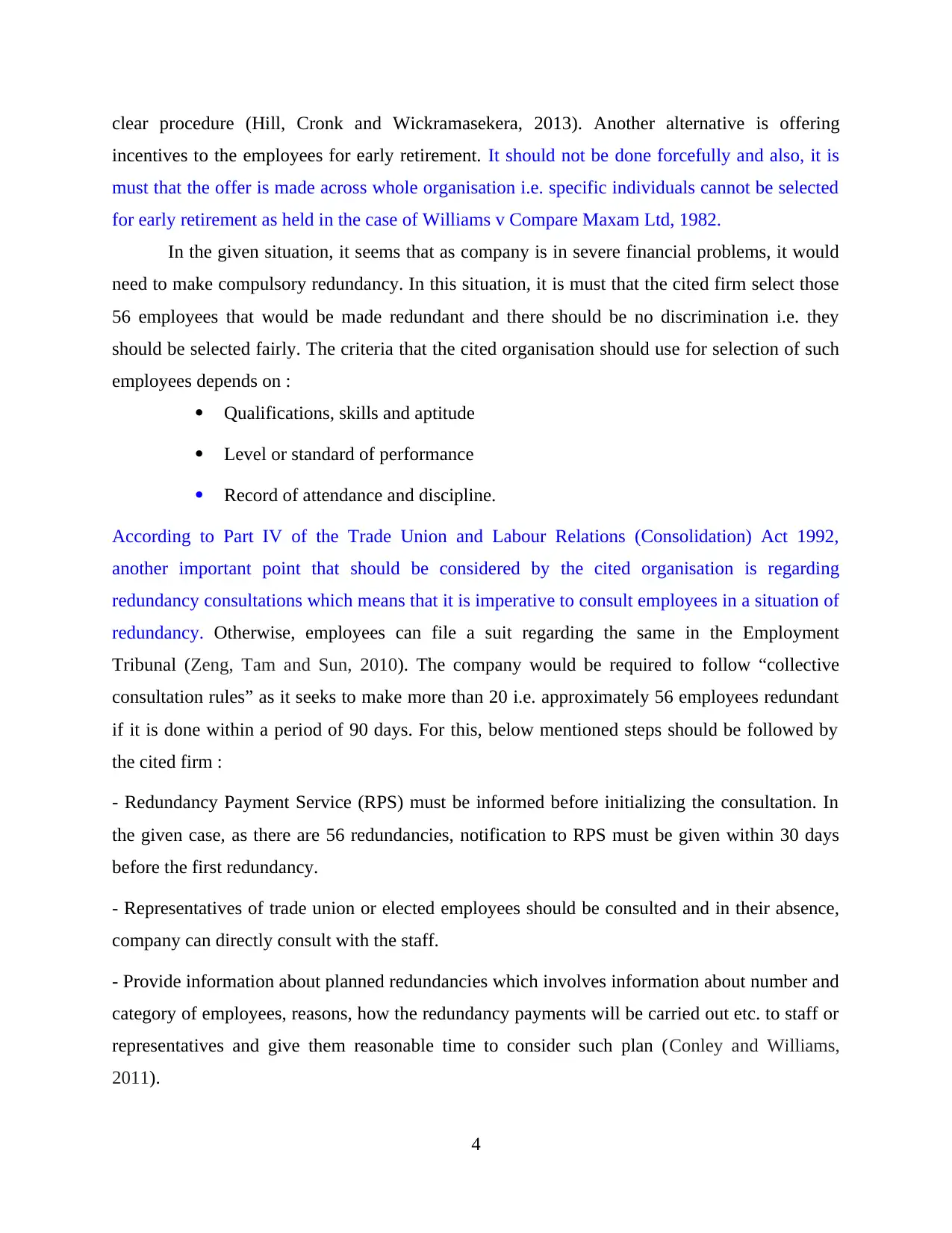
clear procedure (Hill, Cronk and Wickramasekera, 2013). Another alternative is offering
incentives to the employees for early retirement. It should not be done forcefully and also, it is
must that the offer is made across whole organisation i.e. specific individuals cannot be selected
for early retirement as held in the case of Williams v Compare Maxam Ltd, 1982.
In the given situation, it seems that as company is in severe financial problems, it would
need to make compulsory redundancy. In this situation, it is must that the cited firm select those
56 employees that would be made redundant and there should be no discrimination i.e. they
should be selected fairly. The criteria that the cited organisation should use for selection of such
employees depends on :
Qualifications, skills and aptitude
Level or standard of performance
Record of attendance and discipline.
According to Part IV of the Trade Union and Labour Relations (Consolidation) Act 1992,
another important point that should be considered by the cited organisation is regarding
redundancy consultations which means that it is imperative to consult employees in a situation of
redundancy. Otherwise, employees can file a suit regarding the same in the Employment
Tribunal (Zeng, Tam and Sun, 2010). The company would be required to follow “collective
consultation rules” as it seeks to make more than 20 i.e. approximately 56 employees redundant
if it is done within a period of 90 days. For this, below mentioned steps should be followed by
the cited firm :
- Redundancy Payment Service (RPS) must be informed before initializing the consultation. In
the given case, as there are 56 redundancies, notification to RPS must be given within 30 days
before the first redundancy.
- Representatives of trade union or elected employees should be consulted and in their absence,
company can directly consult with the staff.
- Provide information about planned redundancies which involves information about number and
category of employees, reasons, how the redundancy payments will be carried out etc. to staff or
representatives and give them reasonable time to consider such plan (Conley and Williams,
2011).
4
incentives to the employees for early retirement. It should not be done forcefully and also, it is
must that the offer is made across whole organisation i.e. specific individuals cannot be selected
for early retirement as held in the case of Williams v Compare Maxam Ltd, 1982.
In the given situation, it seems that as company is in severe financial problems, it would
need to make compulsory redundancy. In this situation, it is must that the cited firm select those
56 employees that would be made redundant and there should be no discrimination i.e. they
should be selected fairly. The criteria that the cited organisation should use for selection of such
employees depends on :
Qualifications, skills and aptitude
Level or standard of performance
Record of attendance and discipline.
According to Part IV of the Trade Union and Labour Relations (Consolidation) Act 1992,
another important point that should be considered by the cited organisation is regarding
redundancy consultations which means that it is imperative to consult employees in a situation of
redundancy. Otherwise, employees can file a suit regarding the same in the Employment
Tribunal (Zeng, Tam and Sun, 2010). The company would be required to follow “collective
consultation rules” as it seeks to make more than 20 i.e. approximately 56 employees redundant
if it is done within a period of 90 days. For this, below mentioned steps should be followed by
the cited firm :
- Redundancy Payment Service (RPS) must be informed before initializing the consultation. In
the given case, as there are 56 redundancies, notification to RPS must be given within 30 days
before the first redundancy.
- Representatives of trade union or elected employees should be consulted and in their absence,
company can directly consult with the staff.
- Provide information about planned redundancies which involves information about number and
category of employees, reasons, how the redundancy payments will be carried out etc. to staff or
representatives and give them reasonable time to consider such plan (Conley and Williams,
2011).
4
⊘ This is a preview!⊘
Do you want full access?
Subscribe today to unlock all pages.

Trusted by 1+ million students worldwide
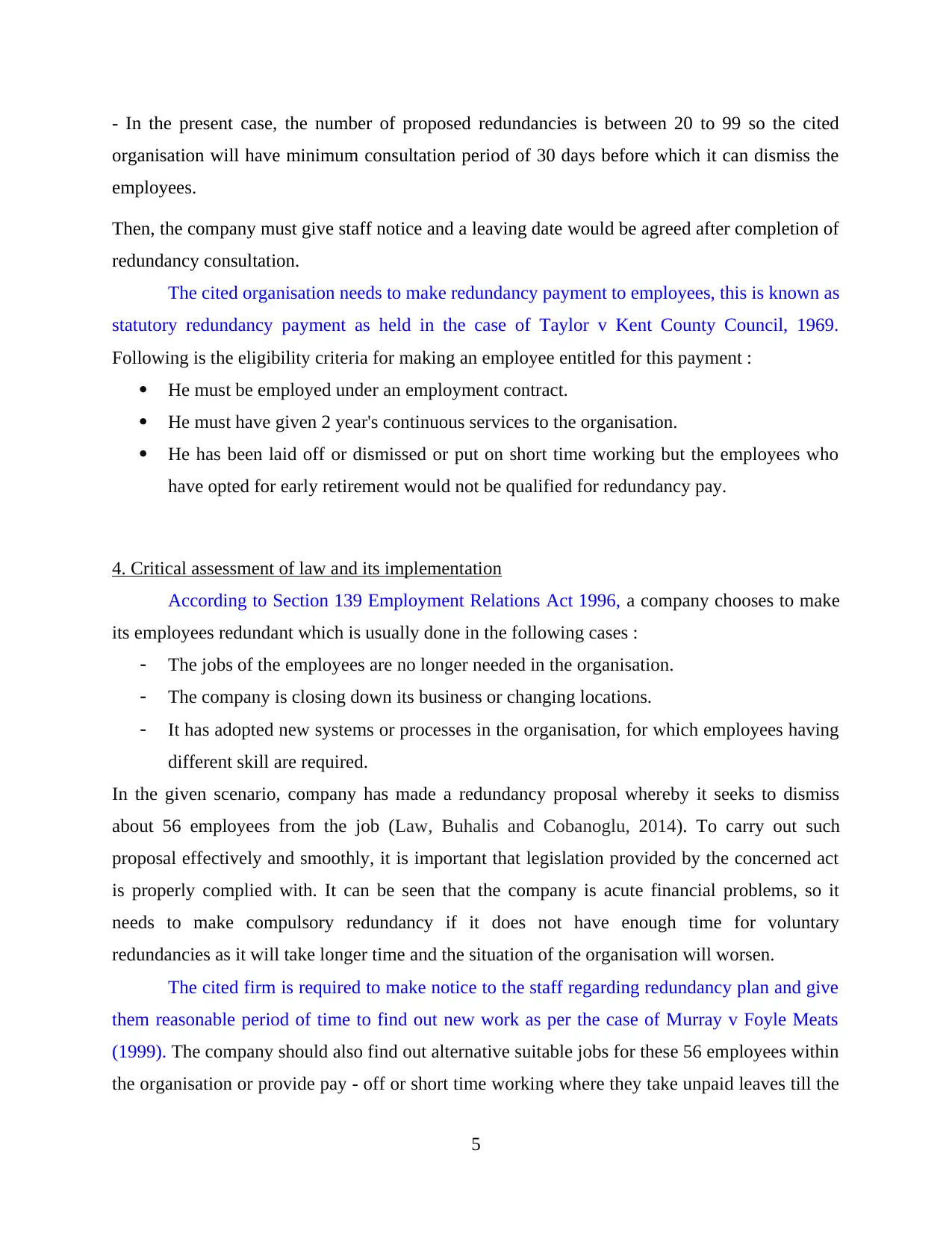
- In the present case, the number of proposed redundancies is between 20 to 99 so the cited
organisation will have minimum consultation period of 30 days before which it can dismiss the
employees.
Then, the company must give staff notice and a leaving date would be agreed after completion of
redundancy consultation.
The cited organisation needs to make redundancy payment to employees, this is known as
statutory redundancy payment as held in the case of Taylor v Kent County Council, 1969.
Following is the eligibility criteria for making an employee entitled for this payment :
He must be employed under an employment contract.
He must have given 2 year's continuous services to the organisation.
He has been laid off or dismissed or put on short time working but the employees who
have opted for early retirement would not be qualified for redundancy pay.
4. Critical assessment of law and its implementation
According to Section 139 Employment Relations Act 1996, a company chooses to make
its employees redundant which is usually done in the following cases :
The jobs of the employees are no longer needed in the organisation.
The company is closing down its business or changing locations.
It has adopted new systems or processes in the organisation, for which employees having
different skill are required.
In the given scenario, company has made a redundancy proposal whereby it seeks to dismiss
about 56 employees from the job (Law, Buhalis and Cobanoglu, 2014). To carry out such
proposal effectively and smoothly, it is important that legislation provided by the concerned act
is properly complied with. It can be seen that the company is acute financial problems, so it
needs to make compulsory redundancy if it does not have enough time for voluntary
redundancies as it will take longer time and the situation of the organisation will worsen.
The cited firm is required to make notice to the staff regarding redundancy plan and give
them reasonable period of time to find out new work as per the case of Murray v Foyle Meats
(1999). The company should also find out alternative suitable jobs for these 56 employees within
the organisation or provide pay - off or short time working where they take unpaid leaves till the
5
organisation will have minimum consultation period of 30 days before which it can dismiss the
employees.
Then, the company must give staff notice and a leaving date would be agreed after completion of
redundancy consultation.
The cited organisation needs to make redundancy payment to employees, this is known as
statutory redundancy payment as held in the case of Taylor v Kent County Council, 1969.
Following is the eligibility criteria for making an employee entitled for this payment :
He must be employed under an employment contract.
He must have given 2 year's continuous services to the organisation.
He has been laid off or dismissed or put on short time working but the employees who
have opted for early retirement would not be qualified for redundancy pay.
4. Critical assessment of law and its implementation
According to Section 139 Employment Relations Act 1996, a company chooses to make
its employees redundant which is usually done in the following cases :
The jobs of the employees are no longer needed in the organisation.
The company is closing down its business or changing locations.
It has adopted new systems or processes in the organisation, for which employees having
different skill are required.
In the given scenario, company has made a redundancy proposal whereby it seeks to dismiss
about 56 employees from the job (Law, Buhalis and Cobanoglu, 2014). To carry out such
proposal effectively and smoothly, it is important that legislation provided by the concerned act
is properly complied with. It can be seen that the company is acute financial problems, so it
needs to make compulsory redundancy if it does not have enough time for voluntary
redundancies as it will take longer time and the situation of the organisation will worsen.
The cited firm is required to make notice to the staff regarding redundancy plan and give
them reasonable period of time to find out new work as per the case of Murray v Foyle Meats
(1999). The company should also find out alternative suitable jobs for these 56 employees within
the organisation or provide pay - off or short time working where they take unpaid leaves till the
5
Paraphrase This Document
Need a fresh take? Get an instant paraphrase of this document with our AI Paraphraser

condition of the firm stabilises (Österle, 2013). As per the law, cited organisation is required to
make redundancy consultation with the representatives of trade unions or elected employees so
that they can be informed about the proposed redundancies. According to Information and
Consultation Employees Regulations 2004, this consultation will include information regarding
reasons for such plan, category and number of employees i.e. 56 in the present case, who would
be made redundant, how this plan would be carried out and how the redundancy pay would be
calculated. Sufficient time to be given to the staff for considering the proposal and proper
response to be given on request of further information.
As redundancy implies dismissal of employees from their jobs, legislation provides
certain rights to them when they are made redundant. The employees have the following rights :
It is mandatory to give a notice period before the end of employment. According to
redundancy law, employees are entitled to a notice of not less than one week's period
when they are employed between 1 month and two years. And in case, if they are
employed between 2 to 12 years, then, one week's notice for each year is required to be
given.
The cited firm must give reasonable time off to employees so that, they can search for
new jobs or arrange for their training (MacKenzie, 2010). The company should also seek
to find out alternative jobs within the organisation that may be suitable for such
employees.
Employees are entitled to statutory guarantee payments if the cited organisation does not
provide full day's work in the normal working hours. The maximum payment that can be
made is £25 a day for 5 days in any 3 months. They would be entitled to get daily usual
wage rate, if they are earning less than £25 per day and for part-time workers, rate is
calculated proportionally.
Another important right with employees is that they can claim for redundancy payment. It
arises when the lay-off or short time working hours runs for not less than 4 weeks
continuously or six or more weeks in a 13 week period, where atmost 3 are in a row. For
claiming this pay, employees are required to give a prior notice stating that they wish to
make a claim.
It is the right of the employees that they are consulted in a redundancy situation otherwise
redundancies made by the company would seem unfair and the organisation can be taken to
6
make redundancy consultation with the representatives of trade unions or elected employees so
that they can be informed about the proposed redundancies. According to Information and
Consultation Employees Regulations 2004, this consultation will include information regarding
reasons for such plan, category and number of employees i.e. 56 in the present case, who would
be made redundant, how this plan would be carried out and how the redundancy pay would be
calculated. Sufficient time to be given to the staff for considering the proposal and proper
response to be given on request of further information.
As redundancy implies dismissal of employees from their jobs, legislation provides
certain rights to them when they are made redundant. The employees have the following rights :
It is mandatory to give a notice period before the end of employment. According to
redundancy law, employees are entitled to a notice of not less than one week's period
when they are employed between 1 month and two years. And in case, if they are
employed between 2 to 12 years, then, one week's notice for each year is required to be
given.
The cited firm must give reasonable time off to employees so that, they can search for
new jobs or arrange for their training (MacKenzie, 2010). The company should also seek
to find out alternative jobs within the organisation that may be suitable for such
employees.
Employees are entitled to statutory guarantee payments if the cited organisation does not
provide full day's work in the normal working hours. The maximum payment that can be
made is £25 a day for 5 days in any 3 months. They would be entitled to get daily usual
wage rate, if they are earning less than £25 per day and for part-time workers, rate is
calculated proportionally.
Another important right with employees is that they can claim for redundancy payment. It
arises when the lay-off or short time working hours runs for not less than 4 weeks
continuously or six or more weeks in a 13 week period, where atmost 3 are in a row. For
claiming this pay, employees are required to give a prior notice stating that they wish to
make a claim.
It is the right of the employees that they are consulted in a redundancy situation otherwise
redundancies made by the company would seem unfair and the organisation can be taken to
6

employment tribunal (Burns, 2010). Collective consultation rules are required to be followed
when there are 20 or more redundancies within 90 days in the single establishment. In the given
case, company is seeking redundancies for about 56 employees so it is required to abide by the
collective consultation rules if it is made within 90 days.
The legislation provides for statutory redundancy pay rates which are based on the age
and tenure of employment and counted back from the date of dismissal. Employees would get :
1.5 weeks' pay for each year of employment after their 41st birthday
half of a week's pay for each year of employment upto their 22nd birthday
a weeks' pay for each year of employment after their 22nd birthday.
The company can allow its staff to leave before planned date of leaving if it offers payment in
lieu of notice. Therefore, the management consultancy company would be required to comply
with all the above mentioned regulations to carry out its redundancy proposals.
5. Discussion and proposition of legal issues
To carry out redundancy proposal is a complex process and the company can face various
issues while implementing such plan in the organisation. The cited organisation has proposed for
redundancies of its employees as it is in financial crisis and unable to pay employees obligations.
This proposal will help the company to reduce its financial burden so that it can come out of
financial difficulty and effectively start its business again.
But there are some legal issues that needs to be resolved before going further with the
redundancy proposal (Dief and Font, 2010) as held in the case of Safeway Stores plc v Burrell
(1997). The cited organisation needs to provide notice to staff about such plan before the time
period specified as per law. But, the company does not have enough time and resources to ensure
that such notices can be sent to the employees, it can only inform them regarding the plan. It is in
severe need of funds and cannot wait longer to carry out this legal procedures.
Moreover, law emphasizes on voluntary redundancy but again constraint of time and
resources would not allow the company to go for that proposal. The cited organisation has to
make compulsory redundancies for which it is required to identify employees who would be
made redundant and this selection should be done fairly. There should be no discrimination on
the basis of age, gender, religion, disability, marriage and civil partnerships, maternity etc.
One of the major issue that the cited firm faces in the current situation is redundancy
payment to employees. It is clear that the company is facing financial crunch and for overcoming
7
when there are 20 or more redundancies within 90 days in the single establishment. In the given
case, company is seeking redundancies for about 56 employees so it is required to abide by the
collective consultation rules if it is made within 90 days.
The legislation provides for statutory redundancy pay rates which are based on the age
and tenure of employment and counted back from the date of dismissal. Employees would get :
1.5 weeks' pay for each year of employment after their 41st birthday
half of a week's pay for each year of employment upto their 22nd birthday
a weeks' pay for each year of employment after their 22nd birthday.
The company can allow its staff to leave before planned date of leaving if it offers payment in
lieu of notice. Therefore, the management consultancy company would be required to comply
with all the above mentioned regulations to carry out its redundancy proposals.
5. Discussion and proposition of legal issues
To carry out redundancy proposal is a complex process and the company can face various
issues while implementing such plan in the organisation. The cited organisation has proposed for
redundancies of its employees as it is in financial crisis and unable to pay employees obligations.
This proposal will help the company to reduce its financial burden so that it can come out of
financial difficulty and effectively start its business again.
But there are some legal issues that needs to be resolved before going further with the
redundancy proposal (Dief and Font, 2010) as held in the case of Safeway Stores plc v Burrell
(1997). The cited organisation needs to provide notice to staff about such plan before the time
period specified as per law. But, the company does not have enough time and resources to ensure
that such notices can be sent to the employees, it can only inform them regarding the plan. It is in
severe need of funds and cannot wait longer to carry out this legal procedures.
Moreover, law emphasizes on voluntary redundancy but again constraint of time and
resources would not allow the company to go for that proposal. The cited organisation has to
make compulsory redundancies for which it is required to identify employees who would be
made redundant and this selection should be done fairly. There should be no discrimination on
the basis of age, gender, religion, disability, marriage and civil partnerships, maternity etc.
One of the major issue that the cited firm faces in the current situation is redundancy
payment to employees. It is clear that the company is facing financial crunch and for overcoming
7
⊘ This is a preview!⊘
Do you want full access?
Subscribe today to unlock all pages.

Trusted by 1+ million students worldwide
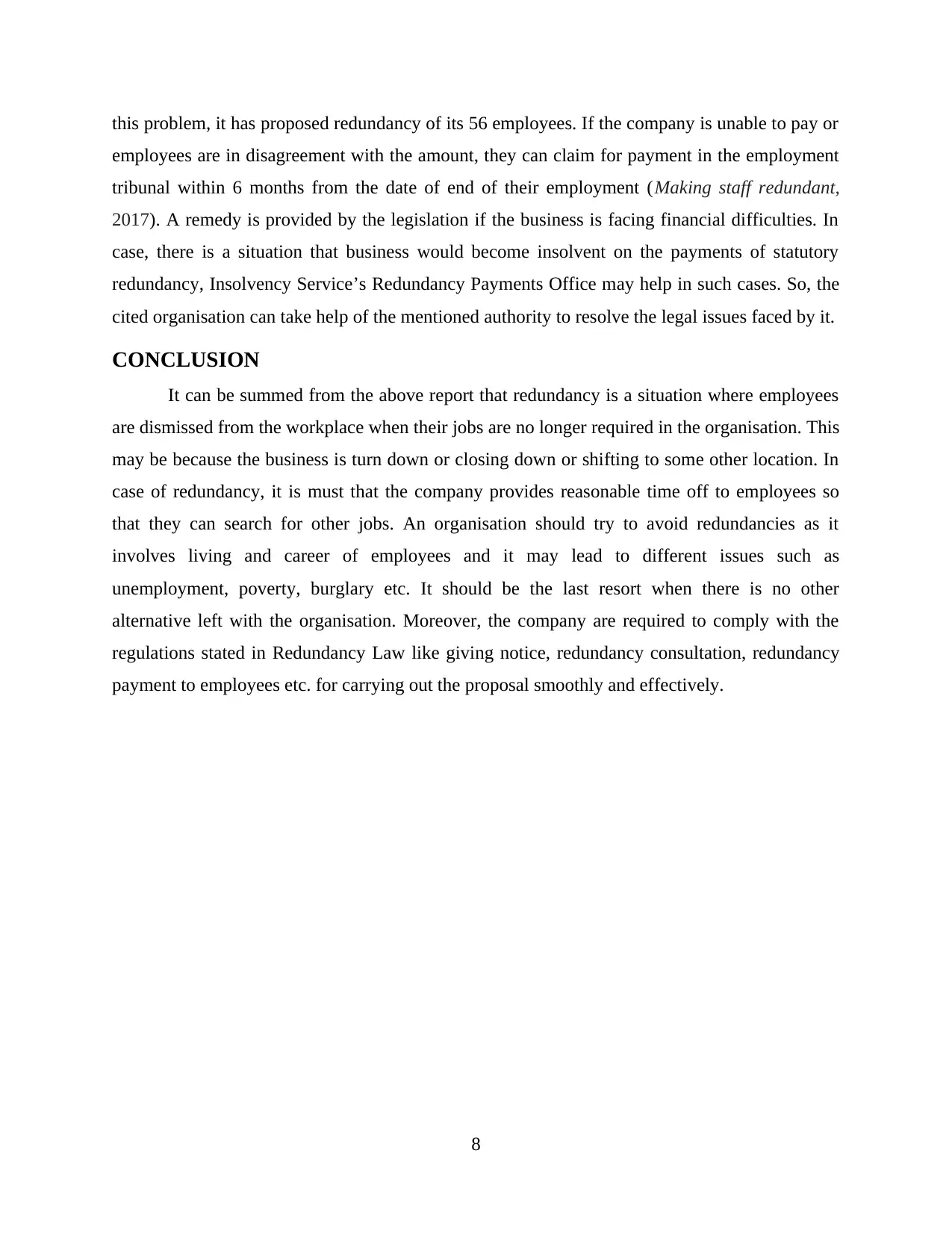
this problem, it has proposed redundancy of its 56 employees. If the company is unable to pay or
employees are in disagreement with the amount, they can claim for payment in the employment
tribunal within 6 months from the date of end of their employment (Making staff redundant,
2017). A remedy is provided by the legislation if the business is facing financial difficulties. In
case, there is a situation that business would become insolvent on the payments of statutory
redundancy, Insolvency Service’s Redundancy Payments Office may help in such cases. So, the
cited organisation can take help of the mentioned authority to resolve the legal issues faced by it.
CONCLUSION
It can be summed from the above report that redundancy is a situation where employees
are dismissed from the workplace when their jobs are no longer required in the organisation. This
may be because the business is turn down or closing down or shifting to some other location. In
case of redundancy, it is must that the company provides reasonable time off to employees so
that they can search for other jobs. An organisation should try to avoid redundancies as it
involves living and career of employees and it may lead to different issues such as
unemployment, poverty, burglary etc. It should be the last resort when there is no other
alternative left with the organisation. Moreover, the company are required to comply with the
regulations stated in Redundancy Law like giving notice, redundancy consultation, redundancy
payment to employees etc. for carrying out the proposal smoothly and effectively.
8
employees are in disagreement with the amount, they can claim for payment in the employment
tribunal within 6 months from the date of end of their employment (Making staff redundant,
2017). A remedy is provided by the legislation if the business is facing financial difficulties. In
case, there is a situation that business would become insolvent on the payments of statutory
redundancy, Insolvency Service’s Redundancy Payments Office may help in such cases. So, the
cited organisation can take help of the mentioned authority to resolve the legal issues faced by it.
CONCLUSION
It can be summed from the above report that redundancy is a situation where employees
are dismissed from the workplace when their jobs are no longer required in the organisation. This
may be because the business is turn down or closing down or shifting to some other location. In
case of redundancy, it is must that the company provides reasonable time off to employees so
that they can search for other jobs. An organisation should try to avoid redundancies as it
involves living and career of employees and it may lead to different issues such as
unemployment, poverty, burglary etc. It should be the last resort when there is no other
alternative left with the organisation. Moreover, the company are required to comply with the
regulations stated in Redundancy Law like giving notice, redundancy consultation, redundancy
payment to employees etc. for carrying out the proposal smoothly and effectively.
8
Paraphrase This Document
Need a fresh take? Get an instant paraphrase of this document with our AI Paraphraser
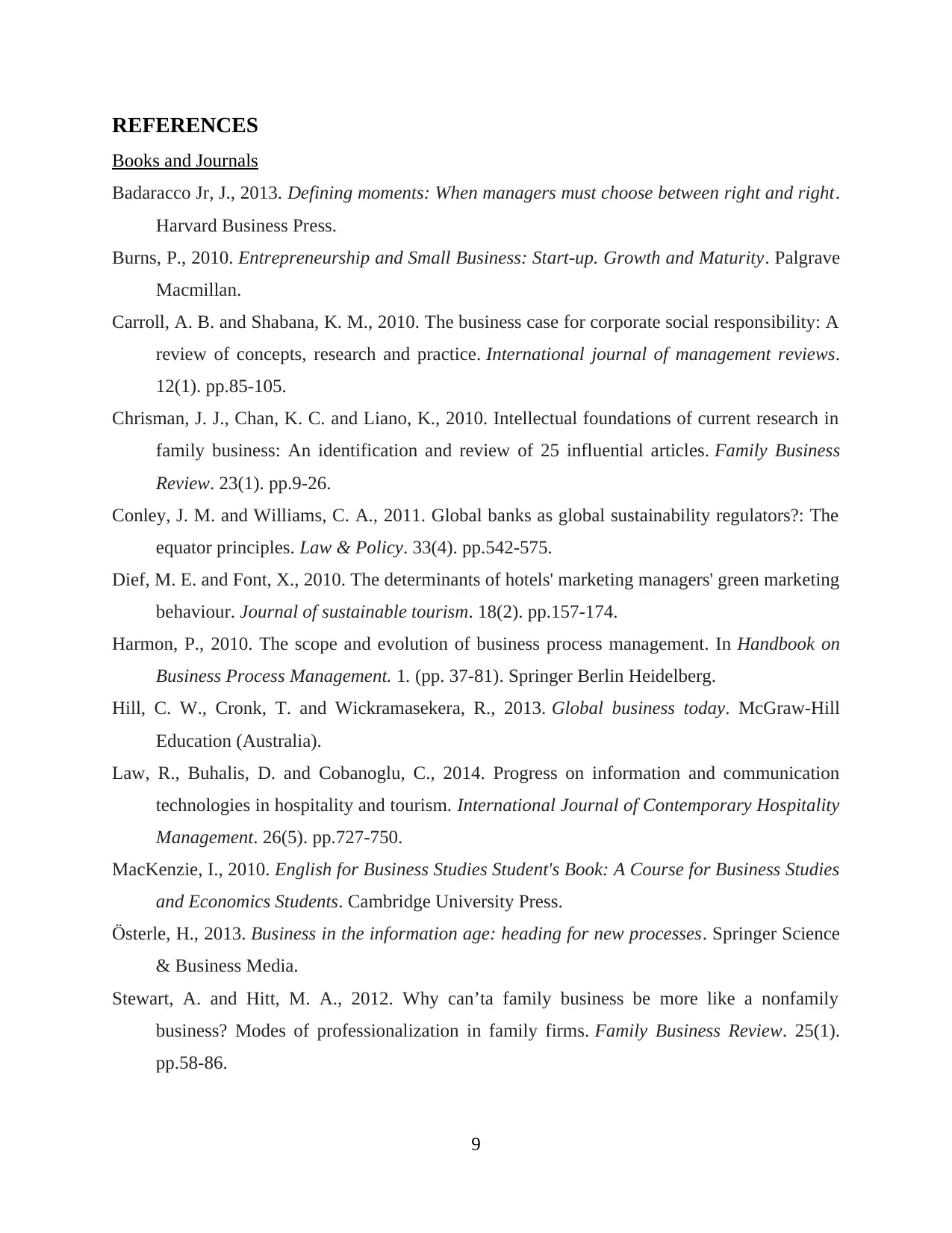
REFERENCES
Books and Journals
Badaracco Jr, J., 2013. Defining moments: When managers must choose between right and right.
Harvard Business Press.
Burns, P., 2010. Entrepreneurship and Small Business: Start-up. Growth and Maturity. Palgrave
Macmillan.
Carroll, A. B. and Shabana, K. M., 2010. The business case for corporate social responsibility: A
review of concepts, research and practice. International journal of management reviews.
12(1). pp.85-105.
Chrisman, J. J., Chan, K. C. and Liano, K., 2010. Intellectual foundations of current research in
family business: An identification and review of 25 influential articles. Family Business
Review. 23(1). pp.9-26.
Conley, J. M. and Williams, C. A., 2011. Global banks as global sustainability regulators?: The
equator principles. Law & Policy. 33(4). pp.542-575.
Dief, M. E. and Font, X., 2010. The determinants of hotels' marketing managers' green marketing
behaviour. Journal of sustainable tourism. 18(2). pp.157-174.
Harmon, P., 2010. The scope and evolution of business process management. In Handbook on
Business Process Management. 1. (pp. 37-81). Springer Berlin Heidelberg.
Hill, C. W., Cronk, T. and Wickramasekera, R., 2013. Global business today. McGraw-Hill
Education (Australia).
Law, R., Buhalis, D. and Cobanoglu, C., 2014. Progress on information and communication
technologies in hospitality and tourism. International Journal of Contemporary Hospitality
Management. 26(5). pp.727-750.
MacKenzie, I., 2010. English for Business Studies Student's Book: A Course for Business Studies
and Economics Students. Cambridge University Press.
Österle, H., 2013. Business in the information age: heading for new processes. Springer Science
& Business Media.
Stewart, A. and Hitt, M. A., 2012. Why can’ta family business be more like a nonfamily
business? Modes of professionalization in family firms. Family Business Review. 25(1).
pp.58-86.
9
Books and Journals
Badaracco Jr, J., 2013. Defining moments: When managers must choose between right and right.
Harvard Business Press.
Burns, P., 2010. Entrepreneurship and Small Business: Start-up. Growth and Maturity. Palgrave
Macmillan.
Carroll, A. B. and Shabana, K. M., 2010. The business case for corporate social responsibility: A
review of concepts, research and practice. International journal of management reviews.
12(1). pp.85-105.
Chrisman, J. J., Chan, K. C. and Liano, K., 2010. Intellectual foundations of current research in
family business: An identification and review of 25 influential articles. Family Business
Review. 23(1). pp.9-26.
Conley, J. M. and Williams, C. A., 2011. Global banks as global sustainability regulators?: The
equator principles. Law & Policy. 33(4). pp.542-575.
Dief, M. E. and Font, X., 2010. The determinants of hotels' marketing managers' green marketing
behaviour. Journal of sustainable tourism. 18(2). pp.157-174.
Harmon, P., 2010. The scope and evolution of business process management. In Handbook on
Business Process Management. 1. (pp. 37-81). Springer Berlin Heidelberg.
Hill, C. W., Cronk, T. and Wickramasekera, R., 2013. Global business today. McGraw-Hill
Education (Australia).
Law, R., Buhalis, D. and Cobanoglu, C., 2014. Progress on information and communication
technologies in hospitality and tourism. International Journal of Contemporary Hospitality
Management. 26(5). pp.727-750.
MacKenzie, I., 2010. English for Business Studies Student's Book: A Course for Business Studies
and Economics Students. Cambridge University Press.
Österle, H., 2013. Business in the information age: heading for new processes. Springer Science
& Business Media.
Stewart, A. and Hitt, M. A., 2012. Why can’ta family business be more like a nonfamily
business? Modes of professionalization in family firms. Family Business Review. 25(1).
pp.58-86.
9
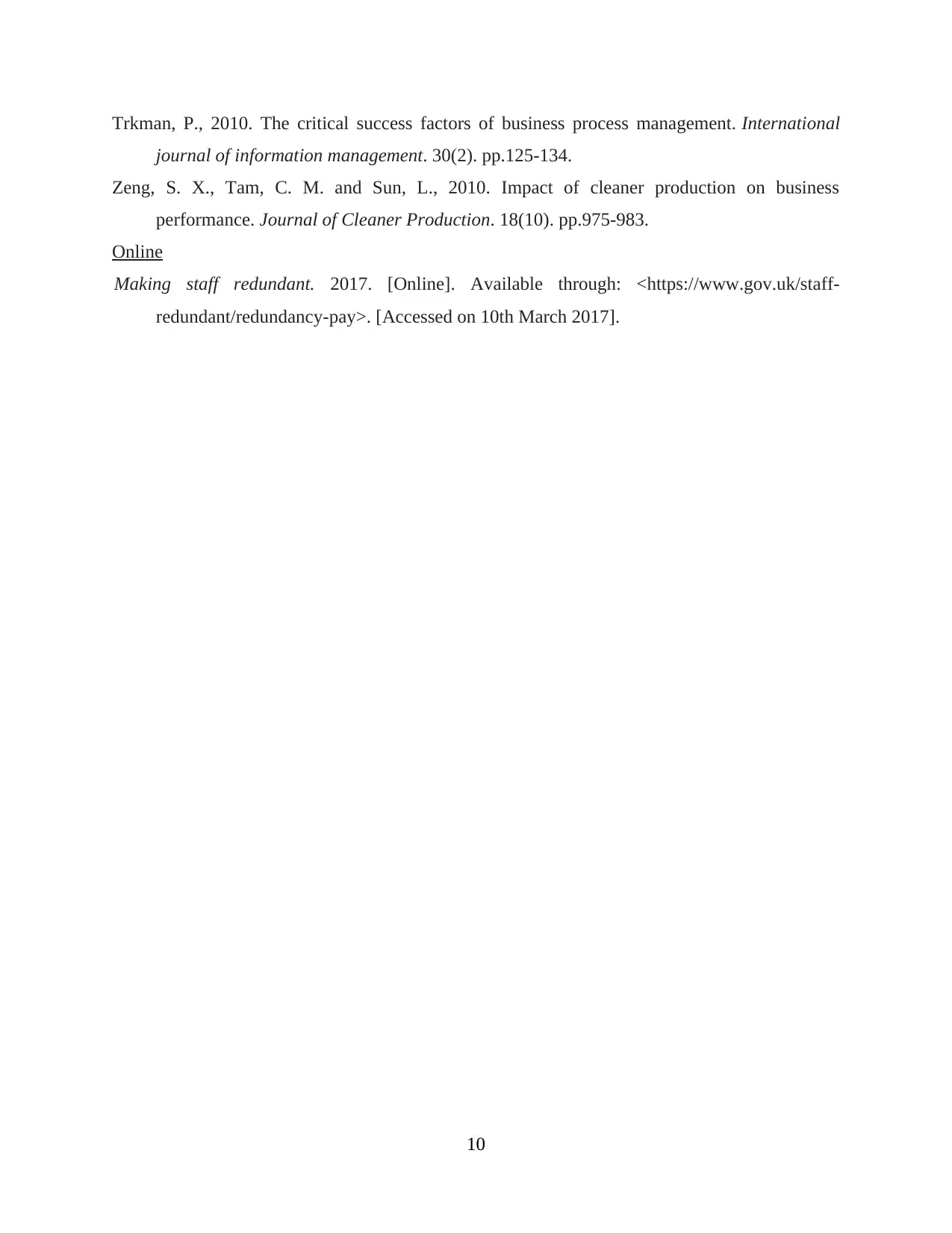
Trkman, P., 2010. The critical success factors of business process management. International
journal of information management. 30(2). pp.125-134.
Zeng, S. X., Tam, C. M. and Sun, L., 2010. Impact of cleaner production on business
performance. Journal of Cleaner Production. 18(10). pp.975-983.
Online
Making staff redundant. 2017. [Online]. Available through: <https://www.gov.uk/staff-
redundant/redundancy-pay>. [Accessed on 10th March 2017].
10
journal of information management. 30(2). pp.125-134.
Zeng, S. X., Tam, C. M. and Sun, L., 2010. Impact of cleaner production on business
performance. Journal of Cleaner Production. 18(10). pp.975-983.
Online
Making staff redundant. 2017. [Online]. Available through: <https://www.gov.uk/staff-
redundant/redundancy-pay>. [Accessed on 10th March 2017].
10
⊘ This is a preview!⊘
Do you want full access?
Subscribe today to unlock all pages.

Trusted by 1+ million students worldwide
1 out of 12
Related Documents
Your All-in-One AI-Powered Toolkit for Academic Success.
+13062052269
info@desklib.com
Available 24*7 on WhatsApp / Email
![[object Object]](/_next/static/media/star-bottom.7253800d.svg)
Unlock your academic potential
Copyright © 2020–2025 A2Z Services. All Rights Reserved. Developed and managed by ZUCOL.





